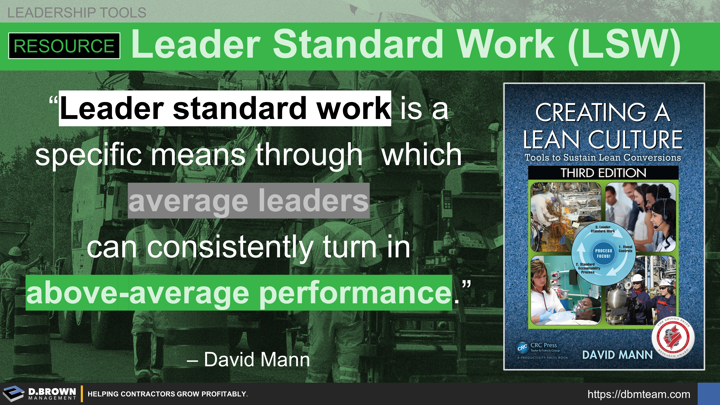What would it be worth for your career and company to shorten the time it takes to develop a foreman, superintendent, or project manager by 50% while increasing the candidate pool of those with the right aptitudes by 100-500% or more?
Leader Standard Work (LSW) Template for Field Leaders
Chad Burroughs succinctly defines standard work:
"Standardized Work describes the process of documenting the steps of a work process, assigning roles, and determining the ideal sequence of those steps with the goal of establishing and maintaining consistency."
Standardized work for front-line tasks have been used to solve labor shortage problems since WWII and before. Learn more: Job Instruction (JI): A 1940s Solution to the Craft Labor Shortage
Delivering consistent outcomes that meet company standards and the business model given the wide range of inconsistent inputs is one of the two foundational accountabilities of a manager.
- Leader Standard Work (LSW) is the equivalent for everyone from front-line supervisors like a crew leader through VPs and C-Level.
- LSW is like any other standard and will progressively develop with each stage of growth for the company and as people grow in their careers.
- LSW is integrated with but is not the same as calendar management, time management, and to-do lists.
- LSW is difficult to get in place. Test it with yourself first and learn. The initial few iterations usually involve being a pendulum between trying to be too regimented which creates stifling levels of control, or being too flexible which isn't trainable and therefore limits scalability.
- LSW is the scheduling component that augments job descriptions and the responsibility assignment matrix for the company, function, and project. Aligned schedules = aligned teams = outcomes.
Below are a series of resources that we've found valuable in helping ourselves, our clients, and those we coach 1:1 implement Leader Standard Work (LSW) starting with choosing whether it is the right tool or not.
Jason Schroeder (Elevating Construction Superintendents) provides very practical examples of how to implement LSW. He has a great analogy in the beginning that hits home hard about how valuable your time is.
In this more detailed video, Jason provides very specific project leadership examples of Leader Standard Work (LSW) and the types of things that would get routinely scheduled.
Supporting article (Elevate Construction / Jason Schroeder)
David Mann in Creating a Lean Culture does the best job we've seen of describing how LSW fits into an overall management system - see chapter 3. Recommend getting this book in all formats for reference.
"Leader standard work is a specific means through which average leaders can consistently turn in above-average performance." - David Mann
While no one wants to think of themselves as "average," the truth is that 49.9999% of us are technically "below average" and that bell curve exists within every contractor. The shortages of experienced talent will only continue to worsen through 2030. The contractors that will dominate tomorrow are the ones that are focusing on accelerating training, development, and support systems today.
Drew Locher, author of multiple award-winning books on streamlining operations has two videos on Leader Standard Work (LSW) that describe how it fits into broader management system.
Additional Resources
- Building Manager Standard Work (Industry Week Article)
- Leader Standard Work: A fundamental shift in management philosophy (Article)
- Leader Standard Work (LSW) Template Example
- Excel Template for Field Leadership (DBM)
- Leader Standard Work (LSW) from Elevate Construction (Article / Template Layout)
- Making Leader Standard Work Visible (Using a Whiteboard / Article)
- Google Search (Articles, Images, Videos)
The tool is much more valuable and the implementation much more challenging than you would initially expect. We will gladly share our experiences with contractors at all stages of growth and people in all stages of their careers, both the wins and the problems. All relationships begin with a simple conversation - let's talk.

